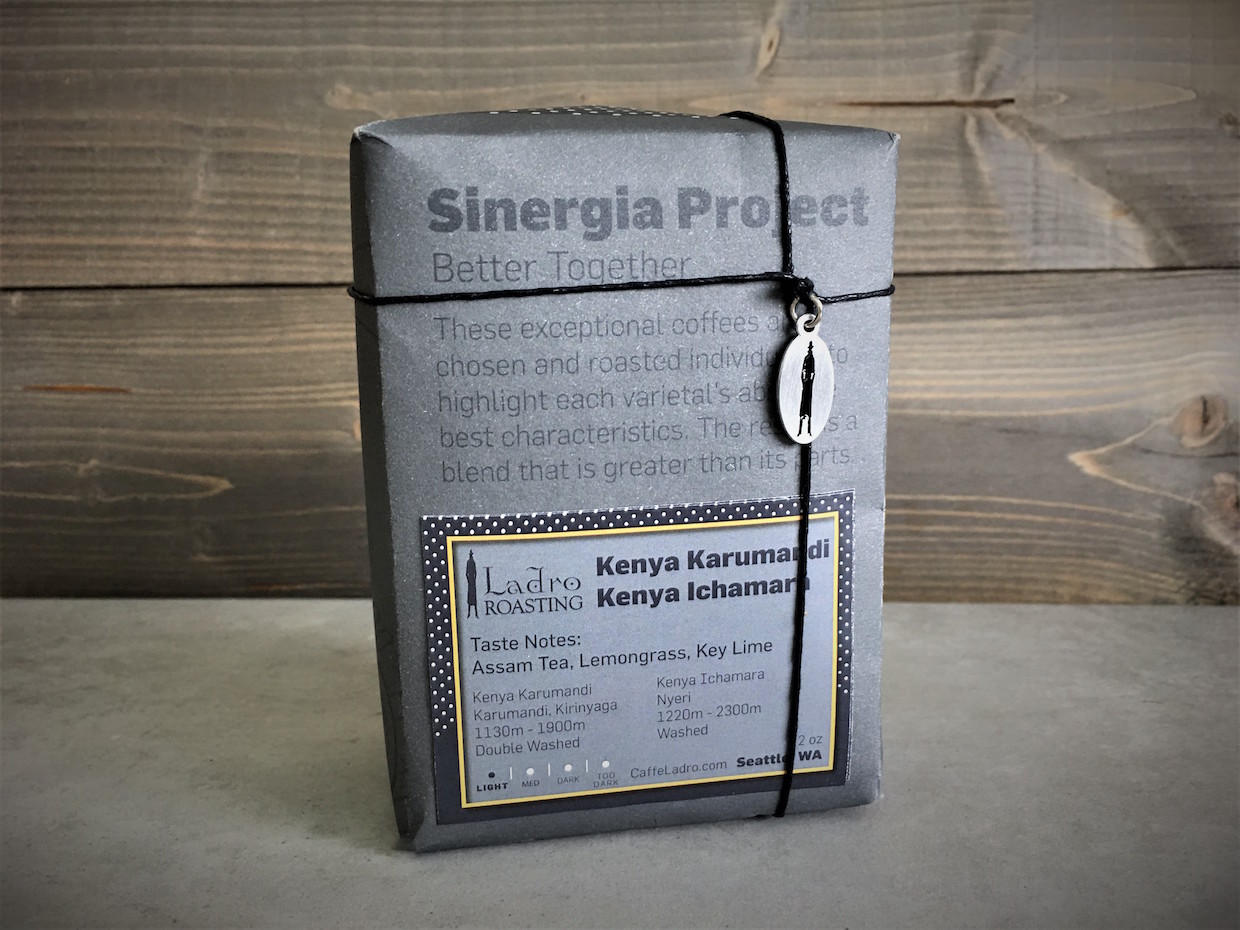
Caffe Ladro’s Sinergia blend packaging, which stands in contrast to the company’s typical packaging with mago labels. Photo courtesy of Caffe Ladro.
Ladro Roasting CEO Jack Kelly found inspiration for his new line of coffees in a bottle of fine wine.
“One of my favorite wine regions is Chateauneuf du Pape,” said Kelly, who founded Seattle-based Caffe Ladro in 1994. “Everything they do is blends. It’s an aspect of the roaster and blender’s skill that is really exciting.”
The European idea of combining two or more great things to make something even better has inspired Sinergia, Ladro’s new line of high-end blends. Considered as a product line, Sinergia represents an interesting strategy toward high-end differentiation. Many roasters these days tend to feature solo single-origin coffees as limited releases, while relegating blending more toward everyday offerings that provide menu staples at comfortable price points.
The first Sinergia blend, released Oct. 13, is composed of two Kenyan coffees: a heavier-bodied Kenya Karumandi from Kirinyaga county and a citrus-forward Kenya Ichamara from Nyeri county. Kelly said results from the cupping table showed potential for combining a coffee with a “great buttery body and roasted tomato acidity” with another sparkling with key lime citrus notes. The package boasts of Assam tea, lemongrass and key lime.
“If you’re taking one of these coffees and doing it separately, you’re trying to highlight the body,” Kelly said. “In the other one (you’re) trying to highlight the acidity… By blending them both, you can take them both to their extreme. Then you get the full range.”
Becoming a Seattle specialty coffee staple over the past 23 years, Caffe Ladro now has 15 cafes in the area. The company started roasting under the Ladro Roasting name in 2011, and head roaster Ryan Rabaca helms a vintage 45-kilo Probat roaster. Greens are sourced through a combination of direct associations and importers, with the Kenyan coffees for the initial Sinergia offering coming from Royal Coffee.
To differentiate the Sinergia line from its normal offerings, the package is a sleek dark gray, a subtle contrast to Ladro’s bright mango labels. Ladro means thief, and the tiny coffee bandit in Ladro’s logo dangles from each Sinergia bag on a small charm.
Kelly suggested the high-end blend strategy extends beyond typical third-wave practices, especially in that it hopes to achieve maximum quality without the price restrictions normally associated with blends. At $21.25 for 12 ounces, the Kenyan Sinergia costs about $5 more than Ladro’s Kenya Yara Estate Peaberry, and $8 more than its other core blends.
“Blending is typically a result of people trying to keep price points reasonable,” Kelly said. “If price is not a part of the formula, so what can you do? We can put these things together and get something really thrilling.”
The components of each Sinergia blend won’t necessarily be offered individually, Kelly said. And not every blend will be from a single country or even continent of origin. He can imagine future combinations of Sumatran and Ethiopian coffees, or blending a strawberry-forward natural process Pacamara with a chocolatey coffee from Brazil.
“Maybe the flavor profiles aren’t that complementary,” Kelly said, “but what we can do in the separate roasting processes is make them complementary. We can create something with amazing range. That’s what this project is about.”
Caffe Ladro hopes to have one to two examples of Sinergia at a time available in its cafes. Just like with a blend of grenache, mourvedre and a splash of syrah, Kelly hopes each Sinergia will improve upon its parts.
“One coffee may be spectacular in one aspect of it,” Kelly said. “But that perfect balance is really rare.”
Lindsay Christians
Lindsay Christians (@LindsayC608) is a full-time food and arts journalist for The Capital Times in Madison, Wisconsin. She is the host of a weekly food podcast called The Corner Table.






Comment